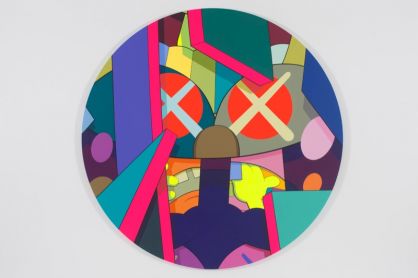KAWS – PERROTIN
Kaws « Imaginary Friends »
KAWS is many things to many audiences. He is an artist, a collector, a designer, a brand, a celebrity, and an entrepreneur. These multiple identities, which are both autonomous and interdependent at the same time, point toward an interconnectedness in contemporary culture between real and virtual worlds, between the personal and the public – art, technology, life and the seamless relationship between and among them in the era of social media. Boundaries between people, places, and things today are fluid and porous giving rise to a new visual language that facilitates a dynamic social and cultural exchange. KAWS speaks this language, incorporating familiar images in his work, which in their different permutations function as a multiplicity of signs and symbols that communicate all at once something new and strange.
His work is multilayered with art historical associations and allusions that betoken a practice motivated by recent art history, shaped by a keen understanding of how images function emotionally and intellectually, and driven by a passionate, almost existential relish for painting. For example, works by KAWS recall the early Hard-edge abstractions of Stella and Noland, or the serial repetition of Warhol, or perhaps also the frenetic energy of Lichtenstein’s diagonal stripes and Benday patterns. You can trace the multiple strands of influence in KAWS elsewhere – from the sophisticated formal conventions of Japanese woodblock prints to the sensational imagery of postwar graphic design in Japan, to the irreverent delight of the Chicago Imagists and their Bay area counterparts in everything grotesque and raunchy.
KAWS’s use of color is very specific and is charted out in schematic drawings that delineate areas of unmodulated hues, establishing formal rhythms and relationships. In elaborate works such as “HALF FULL” and “HALF EMPTY”, these monochromatic shapes stand alone as color fields that have all the associative capacity of Ellsworth Kelly’s shaped paintings, while together representing fragments of a complex, multi-dimensional whole. Images in these works emerge from a violent clash of intensely saturated color and appropriately seem to depict figures engaged in a fistfight. Their color combinations recall the dark architectural fantasies of the late Al Held and summon the 1980s era of New Romanticism, video gaming, and celebration of all things synthetic. The 1980s are, in fact, a wellspring of influence for KAWS – we arrive at “COMPANION”, for example, by way of Jeff Koons’ faux-inflatable “Rabbit”; through Raymond Pettibon’s comics inspired album and zine covers; and Keith Haring’s irrepressible “Radiant Baby.”
The AIDS-related work of General Idea in the 1980s also seems relevant to how images like “COMPANION” and “CHUM” function: GI’s interest in Burroughs’ “word virus” led them to invent their own “image virus” conflating Robert Indiana’s “Love” logo with the acronym AIDS. Similarly, by appropriating and modifying the well-known Michelin Man, KAWS has invented an ambiguous image that is imprinted upon our consciousness like a retinal afterimage. It insists itself upon our imagination through its unlimited repetition and its aggressive posture, thrusting toward us like an offensive lineman. All of the identical contours of the nine “CHUM” paintings in the exhibition are painted with unique color combinations. Viewed in rapid sequence, they begin to have the pulsating effect of concentric rings in Noland’s iconic target paintings while at the same time evoking the words of Kandinsky, becoming quite literally “vibrations of the soul” – words that inspired the theory of equivalence that so inspired Alfred Stieglitz in the early 20th-century. Perhaps “CHUM”, “COMPANION”, and their accomplices are equivalents for KAWS himself, representing many different things to many different people while corresponding to shifting states of awareness, feelings, and the distant interconnectedness that conditions who we are now and how we relate to a world continually in flux.
Michael Rooks
Wieland Family Curator of Modern and Contemporary Art
